





So many African violets so little shelf space! Fortunately, there's a solution. Welcome to the charming world of MINIATURE African violets.
Miniature African violets come in the same remarkable variety of colors, blossom forms, foliage types, and so forth that you'll find in their bigger siblings. But they take up only a fraction of the space on your plant shelf or windowsill. For me, that does not mean less space devoted to plants. It does mean I can fit a lot more pretty little bloomers into the same amount of space! Although they look dainty, they are as tough as standard sized plants. A few care tips will make it easy for you to add a "mini" or two to your own indoor plant collection!
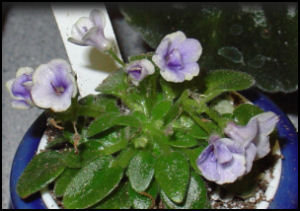 Miniature African violets (AVs) are genetically distinct from their larger counterparts. AVs come in three recognized sizes: standard, semi-miniature, and miniature. When mature, semi-miniatures grow to less than 8 inches in diameter and miniatures to less than 6 inches, with many being much smaller. Although you can force a standard AV to maintain a small leaf size and small diameter by dwarfing it in a little container, it may never bloom, and it may eventually become unhappy and die. Standard African violets are hybrid varieties descended from the species Saintpaulia ionantha. Mini and semi-mini AV hybrids resulted when the smaller species Saintpaulia pusilla or Saintpaulia shumensis were added to the genetic mix. [1]
Miniature African violets (AVs) are genetically distinct from their larger counterparts. AVs come in three recognized sizes: standard, semi-miniature, and miniature. When mature, semi-miniatures grow to less than 8 inches in diameter and miniatures to less than 6 inches, with many being much smaller. Although you can force a standard AV to maintain a small leaf size and small diameter by dwarfing it in a little container, it may never bloom, and it may eventually become unhappy and die. Standard African violets are hybrid varieties descended from the species Saintpaulia ionantha. Mini and semi-mini AV hybrids resulted when the smaller species Saintpaulia pusilla or Saintpaulia shumensis were added to the genetic mix. [1]
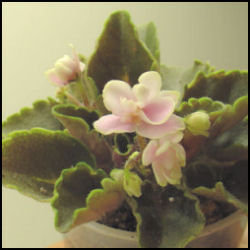 Grooming, repotting, and propagating techniques are pretty much the same for African violets of all sizes. The smaller scale of the mini AVs can make them a little challenging to work with. You may find that it's easier to use the tip of a pencil rather than your finger to dislodge suckers. Little embroidery scissors are useful for trimming away flower stalks and leaf stubs. Although I usually bottom water or wick water, for occasional top watering it's useful to have a plastic squeeze bottle or watering can with a small spout.
Grooming, repotting, and propagating techniques are pretty much the same for African violets of all sizes. The smaller scale of the mini AVs can make them a little challenging to work with. You may find that it's easier to use the tip of a pencil rather than your finger to dislodge suckers. Little embroidery scissors are useful for trimming away flower stalks and leaf stubs. Although I usually bottom water or wick water, for occasional top watering it's useful to have a plastic squeeze bottle or watering can with a small spout.
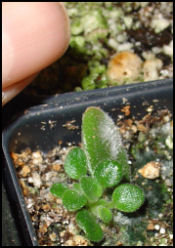 Overpotting is one of the most common mistakes people make with African violets, and it's especially easy to do with mini AVs. Putting a miniature AV into a 4 inch pot won't make it grow larger, but it may lead to "wet feet" and root rot issues. When you repot a mature mini, it's generally best to put it back into the same size pot, trimming the bottom of the root ball a bit if you need to plant it more deeply to cover a bare "neck." Most miniature plants will never need anything larger than a 1 ½ or 2 inch diameter pot (3 inches for semi-miniatures). As with standard African violets, the diameter of the plant can be up to three times the diameter of the pot.
Overpotting is one of the most common mistakes people make with African violets, and it's especially easy to do with mini AVs. Putting a miniature AV into a 4 inch pot won't make it grow larger, but it may lead to "wet feet" and root rot issues. When you repot a mature mini, it's generally best to put it back into the same size pot, trimming the bottom of the root ball a bit if you need to plant it more deeply to cover a bare "neck." Most miniature plants will never need anything larger than a 1 ½ or 2 inch diameter pot (3 inches for semi-miniatures). As with standard African violets, the diameter of the plant can be up to three times the diameter of the pot. 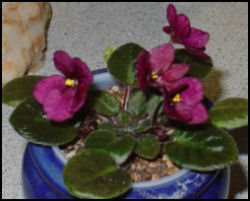 African violets don't need or want extra room around their roots. Repotting a mature plant isn't done to give it a bigger pot but simply to refresh the soil and to give the plant a boost.
African violets don't need or want extra room around their roots. Repotting a mature plant isn't done to give it a bigger pot but simply to refresh the soil and to give the plant a boost.
Miniature AVs like the same light potting mix that standards seem to prefer. I use a little more than one part perlite to one part good quality soil-less potting mix. I also add just a pinch of polymer moisture crystals, without which I'd probably have to water these little every 4 to 5 days rather than once a week. Follow directions with the moisture crystals; adding too many will make the lit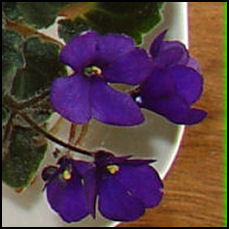 tle plant heave right out of the pot as the crystals expand with water. Miniatures will appreciate repotting more often than the annual repotting that seems sufficient for most standards.
tle plant heave right out of the pot as the crystals expand with water. Miniatures will appreciate repotting more often than the annual repotting that seems sufficient for most standards.
Don't be intimidated by the delicate stems and little leaves of miniature African violets. 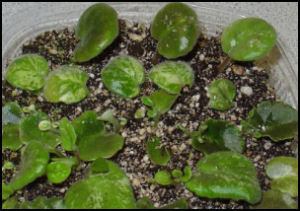 They're just as easy to propagate as the standard size ones. Plastic "clamshell" takeout containers with holes in the top (for ventilation) and bottom (for drainage) make great propagation trays for the tiny leaves or suckers of miniature AVs. Plantlets can potted up initially in 1 inch plastic condiment cups with a hole in the bottom for drainage. When the roots fill the cup, pot up into a slightly larger container.
They're just as easy to propagate as the standard size ones. Plastic "clamshell" takeout containers with holes in the top (for ventilation) and bottom (for drainage) make great propagation trays for the tiny leaves or suckers of miniature AVs. Plantlets can potted up initially in 1 inch plastic condiment cups with a hole in the bottom for drainage. When the roots fill the cup, pot up into a slightly larger container.
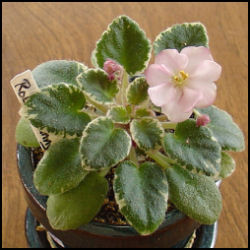 Some hybridizers specialize in miniature AVs. Dr. Ralph Robinson (of Rob's Violet Barn) introduces several new miniature or semi-mini varieties each year. His varieties are noted for their strong blooming and are frequent ribbon-winners at shows. H. Pittman is another favorite hybridizer of miniature AVs. The symmetrical, pointed foliage of a Pittman's AV looks so neat and elegant, even when it's not in bloom. The "Storytella" series of minis have the added attraction of fun fairytale names. I've also found miniature "teacup" violets at my local nursery, but named varieties of minis often seem to bloom better for me.
Some hybridizers specialize in miniature AVs. Dr. Ralph Robinson (of Rob's Violet Barn) introduces several new miniature or semi-mini varieties each year. His varieties are noted for their strong blooming and are frequent ribbon-winners at shows. H. Pittman is another favorite hybridizer of miniature AVs. The symmetrical, pointed foliage of a Pittman's AV looks so neat and elegant, even when it's not in bloom. The "Storytella" series of minis have the added attraction of fun fairytale names. I've also found miniature "teacup" violets at my local nursery, but named varieties of minis often seem to bloom better for me.
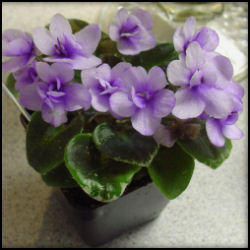 Whether you already have dozens of standard size African violets or have never grown an AV before, I hope you'll try a couple of these diminutive charmers!
Whether you already have dozens of standard size African violets or have never grown an AV before, I hope you'll try a couple of these diminutive charmers!
Photographs by Jill Nicolaus.
[1] Article by Dr. Leonard Perry, extension professor at the Univesity of Vermont
Related Articles by Jill:
African Violets 101: Caring for Your New Plant
Watering African Violets 101
Watch for upcoming articles on Propagating AVs and on using polymer moisture crystals
Also, check out the great information in the culture pages at Rob's Violet Barn
Copyright © www.100flowers.win Botanic Garden All Rights Reserved